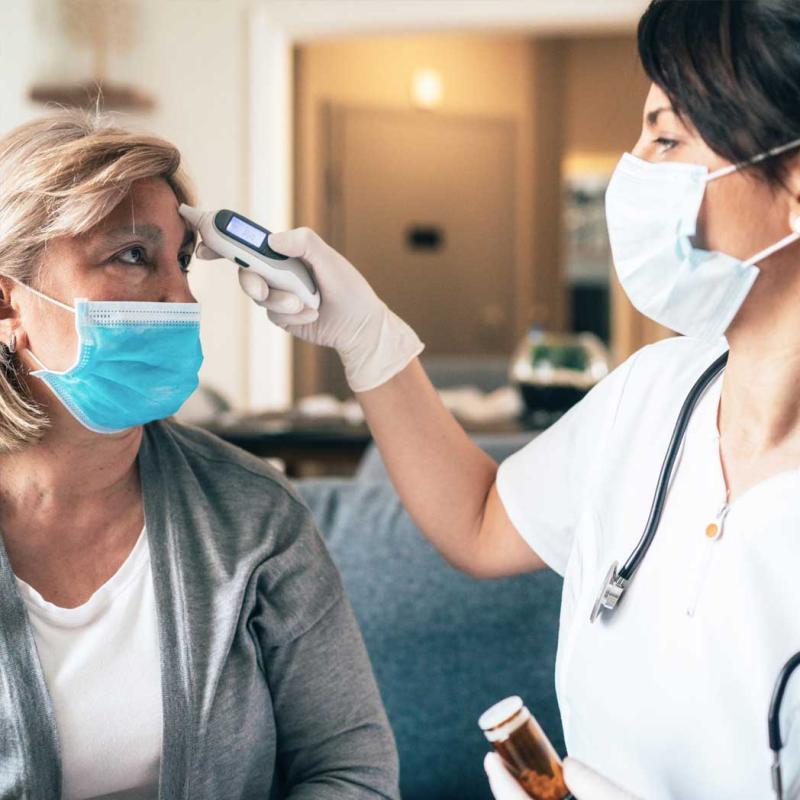As post-pandemic trends come into view, we’ll watch for opportunities to adapt so that, together, we can anticipate and navigate new challenges.
07
2021 + Onward
Lottie file
Perspectives on 2021 and beyond
We continue to monitor the effects of the COVID-19 pandemic:
- Evaluating impact of delaying necessary care on longer-term health trends
- Addressing long-term mental health and well-being
- Analyzing whether plan-specific drivers of trend—benefit design, population health needs, provider/patient utilization patterns—could power plan-specific solutions.

By addressing immediate needs and the evolving nature of the pandemic, we can help organizations open their workplaces safely and keep people physically and mentally healthy for the long-term.
Increases in specialty drug spend are likely to continue
For the first time ever, specialty drug spend surpassed 50% of overall pharmacy spend among commercial plans. We expect this trend to continue as specialty spending could increase 10-15% over the next few years, influenced mainly by existing medications for inflammatory conditions and new drugs for cancer and rare conditions. We anticipate some downward pressure as a result of generic availability for HIV.
Here are four conditions to focus on when it comes to influencing specialty spending:
- Increases in overall trend may continue through 2023, reflecting expanded indications within current therapies and new drugs in the pipeline
- While existing medications to treat atopic dermatitis will continue to be the preferred first line therapy, new drugs approved in 2021 may challenge for market dominance and cause shifts in existing market share for this condition
- Utilization increases may be influenced by new patients using existing medications to treat psoriasis, psoriatic arthritis, Crohn’s disease and ulcerative colitis, as well as by the approval of new drugs—abrocitinib and deucravacitinib—in 2021
- Several lower cost biosimilars for Humira® (adalimumab) are due to enter the market in 2023. Having the appropriate utilization management strategies in place could have significant impact on lowering trend for this class overall
- Unit costs and utilization will likely increase over the next few years, influenced primarily by higher incidence of newly diagnosed cancer patients, as well as by patients living longer due to the effectiveness and advancement of newer therapies. While these factors, along with approvals for combination therapies, may increase utilization, most of the rise in trend will be due to higher medication unit costs.
- New generics for multiple myeloma (pomalidomide) and renal cell carcinoma (sunitinib) will help mitigate rising prices in categories with little or no competition.
- In 2022, high inflation rates should continue with trend growth from expensive oral medications.
- Payers may see an increase in pharmacy spend as self-administered cancer medications move from the medical to the pharmacy benefit.
- We estimate trend will remain at or slightly above 6% through 2023
- The introduction of generics for Selzentry® and Prezista® in 2022-2023 will create long-awaited competition and could offset high-cost medication launches.
- Descovy® (emtricitabine/tenofovir) may continue to gain traction among PrEP patients, and we foresee utilization increases in the generic for Truvada® (emtricitabine/tenofovir disoproxil fumarate)
- Expect utilization increases over the next few years, influenced by awareness campaigns for PrEP therapies which could drive new infections to near zero while making HIV treatment more affordable
- Significant increases in drug spending are very likely over the next few years
- For muscular dystrophy, we expect to see a shift from the medical to the pharmacy benefit as more drug therapies for patients are introduced than were available before
- Availability of newer, effective, more costly medications to treat sickle cell disease is likely to increase utilization and unit costs over the next few years
- The effort to address the debilitating symptoms of amyloidosis—an underdiagnosed, incurable condition—may impact utilization trend. Newer, high-cost medications have had success reversing complications and prolonging patients’ lives
- Costs to treat hemophilia may continue to increase, influenced by the potential availability of expensive gene therapies and increased use of Hemlibra® (emicizumab-kxwh)
$426K
annual cost to payers for one patient with hereditary angioedema, a rare but potentially life-threatening genetic condition affecting 1 in 50,000

